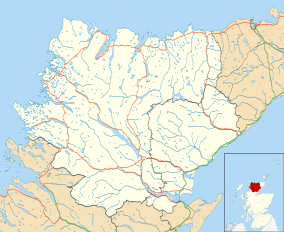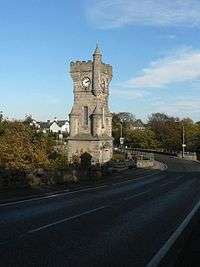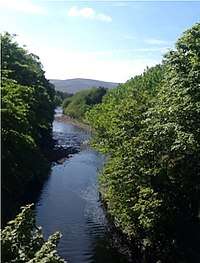Brora
Brora (Scottish Gaelic: Brùra) is a village in the east of Sutherland, in the Highland area of Scotland.
Brora
| |
|---|---|
 Harbour Road, Brora | |
 Brora Location within the Sutherland area | |
| Population | 1,870 (2011)[1] |
| OS grid reference | NC906039 |
| Civil parish |
|
| Council area | |
| Lieutenancy area | |
| Country | Scotland |
| Sovereign state | United Kingdom |
| Post town | BRORA |
| Postcode district | KW9 |
| Dialling code | 01408 |
| Police | Scotland |
| Fire | Scottish |
| Ambulance | Scottish |
| UK Parliament | |
| Scottish Parliament |
|


Origin of the name
The name Brora is derived from ancient Norse, meaning 'river with a bridge.'[2]
History
Brora is a small industrial village, having at one time a coal pit, boat building, salt pans, fish curing, lemonade factory, the new Clynelish Distillery (as well as the old Clynelish distillery which is now called the Brora distillery [3]), wool mill, bricks and a stone quarry. The white sandstone in the Clynelish quarry belongs to the Brora Formation, of the Callovian and Oxfordian stages (formerly Middle Oolite) of the Mid-Late Jurassic. Stone from the quarry was used in the construction of London Bridge, Liverpool Cathedral and Dunrobin Castle. When in operation, the coalmine was the most northerly coalmine in the UK. Brora was the first place in the north of Scotland to have electricity thanks to its wool industry. This distinction gave rise to the local nickname of "Electric City" at the time. Brora also houses a baronial style clock tower which is a war memorial.
Transport
The village is situated where the A9 road and the Far North Line bridge the River Brora. The village is served by a railway station. Buses operate about every two hours Mondays-Saturdays and infrequently on Sundays from Brora to Golspie, Dornoch, Tain and Inverness in the south and Helmsdale, Dunbeath, Lybster, Wick, Castletown, Thurso and Scrabster in the north. These are on routes X98, and X99 and are operated by Stagecoach in the Highlands.
Education
An education is available for primary school children in Brora Primary School in Johnstone Place. The building was formerly Brora High School, that included the primary department. Although the school opened in 1962, the secondary department closed in 1985. It includes a playgroup, nursery and Primaries 1 to 7. Older children are taken by school transportation to the nearby Golspie High School.[4]
Sport
Brora Rangers F.C. were founded in 1879 and have been members of the Highland Football League since 1962. They moved to their present stadium, Dudgeon Park, in 1922. Amongst the local amenities are an 18-hole links golf course designed by James Braid in 1923 for sum of £23, bowling and tennis facilities.
Government listening station
To the south-east of the village is the former Brora Y Station which operated as a Government listening station between 1940 and 1986.[5]
Notable people from Brora
- Megan Boyd (1915–2001), fly-tier.[6]
- Rev Prof William John Cameron, twice Moderator of the General Assembly of the Free Church of Scotland
- Isabella Gordon Mackay was born near here is the 1770s. She created support for Presbyterians in Nova Scotia sending teachers, ministers and more.[7]
References
- "POPULATION CHANGE IN CAITHNESS AND SUTHERLAND 2001 TO 2011". Highland Council. 11 February 2014. Retrieved 11 February 2011.
- Field, John (1984). Discovering Place Names. Shire Publications. ISBN 978-0852637029.
- "Brora". The Wiskey Guide. Archived from the original on 2 April 2009.
- "Golspie High School Catchment Area Map - Rezzio". 14 May 2015. Archived from the original on 11 August 2016. Retrieved 23 June 2016.
- "How Cheltenham entered America's backyard". New Scientist. 5 April 1984. Archived from the original on 27 December 2014. Retrieved 12 December 2014.
- "Megan Boyd". www.scotsman.com. Archived from the original on 25 October 2017. Retrieved 20 June 2019.
- "Mackay, Isabella Gordon [Bella] (1777/8–1850), philanthropist and religious activist". Oxford Dictionary of National Biography. doi:10.1093/ref:odnb/59558. Retrieved 15 August 2020.